In-row rotary tool
In-row rotary tools are used to destroy plant cover, leaving the soil flat, and to incorporate manure and fertiliser. Mounted on inter-row or high-clearance tractors, they are driven by the PTO or a hydraulic motor, sometimes requiring an independent hydraulic power unit. They include tines, spades and retraction systems, mainly hydraulic, to retract in front of the vines.
Maintenance is facilitated by the use of standard components and the speed with which brushes can be replaced.
Maintenance is facilitated by the use of standard components and the speed with which brushes can be replaced.
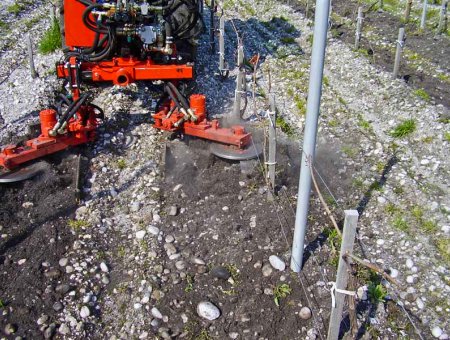
Work objective
Rotary tools are mainly used to destroy plant cover, leaving the soil flat. In some cases, they are used to incorporate manure and fertiliser into the soil.
When mounted behind inter-row tractors, on the 3-point system, they are driven by the tractor's power take-off. The power available can be considerable. In the case of certain mountings on high-clearance tractors, the drive is generally provided by a hydraulic motor. If the tractor has sufficient oil flow, the tool can be connected to the tractor's hydraulic oil intakes. If not, an independent hydraulic unit can be used, which will deliver enough oil to drive the equipment. (Beware of the extra cost).
When mounted behind inter-row tractors, on the 3-point system, they are driven by the tractor's power take-off. The power available can be considerable. In the case of certain mountings on high-clearance tractors, the drive is generally provided by a hydraulic motor. If the tractor has sufficient oil flow, the tool can be connected to the tractor's hydraulic oil intakes. If not, an independent hydraulic unit can be used, which will deliver enough oil to drive the equipment. (Beware of the extra cost).
Components of in-row rotary tools
Manufacturers offer a wide range of tines, spades and rotating parts.- Tools with a vertical axis of rotation
- Tools with a horizontal axis of rotation (although this category is much less common)
The hydraulic motor
The hydraulic motor rotates the tool. It needs to be connected to a single-acting distributor with a free return, as the oil flow required is high (~ 25 l/min).Working parts
Various accessories are available. These are usually tines. Naturagriff has extended its range to include metal brushes instead of teeth.The erasing system
There are two main removal systems for the rotary tool:The hydraulic cylinder
The hydraulic cylinder is the most widely used solution. The cylinder is controlled by a distributor actuated by a feeler and retracts the tool. The valve can be controlled mechanically or electro-hydraulically. Mechanical control requires a little more effort to trigger, but is more progressive. The hydraulic system can be powered by the tractor's oil, or by an independent control unit. At Egretier, the power unit is a closed-circuit unit with a low reservoir capacity (a characteristic linked to the closed circuit), but also the use of a special hydraulic fluid (LHM), so beware of errors.
The hydraulic torque amplifier
The torque amplifier used by Boisselet is a system that combines a rotary distributor coupled to a hydraulic motor in a single unit. Actuating the feeler causes a control shaft to rotate, which in turn causes an output shaft to rotate at the same angle. The role of this device is to multiply the torque between the two shafts. It is a compact, simple and robust device.
The hydraulic cylinder is the most widely used solution. The cylinder is controlled by a distributor actuated by a feeler and retracts the tool. The valve can be controlled mechanically or electro-hydraulically. Mechanical control requires a little more effort to trigger, but is more progressive. The hydraulic system can be powered by the tractor's oil, or by an independent control unit. At Egretier, the power unit is a closed-circuit unit with a low reservoir capacity (a characteristic linked to the closed circuit), but also the use of a special hydraulic fluid (LHM), so beware of errors.
The hydraulic torque amplifier
The torque amplifier used by Boisselet is a system that combines a rotary distributor coupled to a hydraulic motor in a single unit. Actuating the feeler causes a control shaft to rotate, which in turn causes an output shaft to rotate at the same angle. The role of this device is to multiply the torque between the two shafts. It is a compact, simple and robust device.

Examples of intervine rotary tools
The rotary hoe type (with a vertical axis) is the most widely used.Some manufacturers combine them with intervine blades to break up the strip lifted by the blade, enabling weeds to die back more quickly. As with all in-row hydraulic weed control tools, a feeler is used to retract the tool in front of the vines. Adjustment of the feeler is essential, as it determines the safety margin around the vine (see example of the 2 pieces of equipment below).
The DISCOMATIC
The DISCOMATIC is an original piece of equipment. The working part consists of a vertical tube to which three paddles are welded. At the base of the tube, a concave disc removes a small strip of soil which is then thrown into the inter-row by the paddles.
The work carried out is a light rotary stripping.
This equipment enables weed control to be carried out under the row, without the need for prior shodding. The weeds thrown into the inter-row dry out. This equipment gives good results in light soils, but is not suitable for heavy soils because it lacks penetrating power.
A hydraulic torque amplifier is used to release the machine as the vines pass by.
The DISCOMATIC is an original piece of equipment. The working part consists of a vertical tube to which three paddles are welded. At the base of the tube, a concave disc removes a small strip of soil which is then thrown into the inter-row by the paddles.
The work carried out is a light rotary stripping.
This equipment enables weed control to be carried out under the row, without the need for prior shodding. The weeds thrown into the inter-row dry out. This equipment gives good results in light soils, but is not suitable for heavy soils because it lacks penetrating power.
A hydraulic torque amplifier is used to release the machine as the vines pass by.
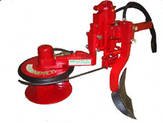
ALTERNACEP
This equipment is a reciprocating hoe on a vertical axis with 200 oscillations per minute. It replicates the work of a hoe. It is very interesting because its reciprocating movement displaces very little soil compared with other rotary tools.
This equipment is a reciprocating hoe on a vertical axis with 200 oscillations per minute. It replicates the work of a hoe. It is very interesting because its reciprocating movement displaces very little soil compared with other rotary tools.
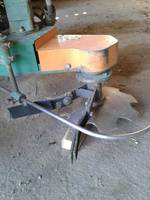
Testimonials from winegrowers using in-row rotary tools
Julien MAILLÉ - Winegrower at Le Pian sur Garonne (Gironde)
"I've been working on the family estate since 2001. In 2010, I took the plunge and decided to set up my own business by taking over the family estate. The surface area is 20 ha, 13 ha of slopes on clay and 7 ha at the bottom of the slopes on sand. "
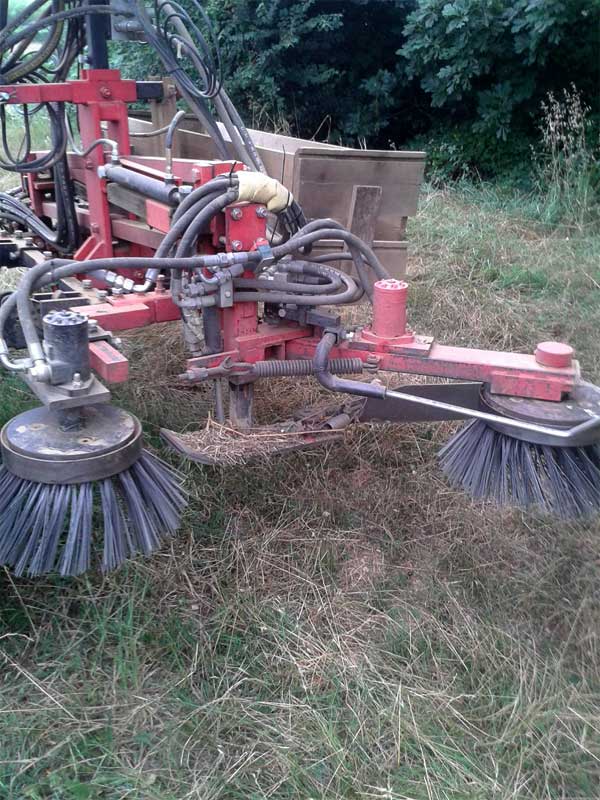
Intervine equipped with 2 brushes per side (Naturagriff)
"An easy-to-use tool
"Following a training course on organic viticulture offered by the Chamber of Agriculture, I decided this year to completely eliminate herbicides on the estate. I was looking for a tool that wouldn't be too restrictive, as I don't have a lot of time to devote to mechanical weeding, and whose chassis would enable me to work my plots with inter-row spacing varying from 3 to 3.50 m. After various trials, I turned to Naturagriff. They offered me a hydraulically extendable chassis that could be adapted to my different spacings. "
"The tool is equipped with a pendulum system and a hydraulic power unit (essential when using rotating tools). "
"The accessories used are rotary cutters and wire brushes with a diameter of 450 mm. The machine is equipped with 2 rotating elements per side, giving me a working width of 70 cm on each side of the row. A deflector is attached to the skid to bring the soil displaced by the rotary tool close to the row. In order to preserve the root system (developed superficially following years of chemical weeding), I'm only using metal brushes for the time being. So far this year, I've made 3 passes with a single set of brushes. A new set will be needed for the fourth pass in August. "
"The advantages of this equipment are the use of standard components for easy maintenance, the presence of a hydraulic power unit, the speed with which the brushes can be replaced (6 bolts per element) and the possibility of working in dry conditions. "
"The limitations are the formation of dust (in dry conditions) and the difficulty of working on slopes because the return of the tool to work is ensured only by a spring. "
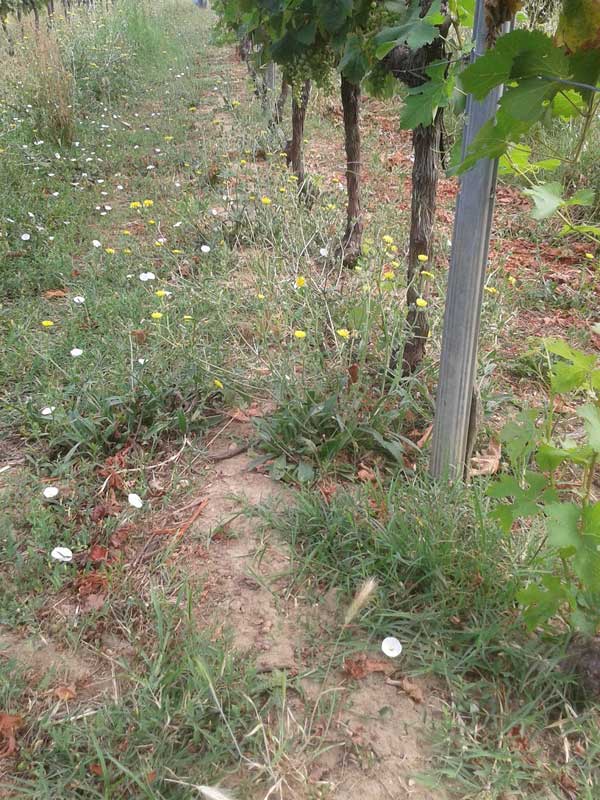
Before brushing

After brushing
"The combination of toothed tool and wire brush is interesting"
" Naturagriff has developed a range of inter-row tools that can be adapted to a single eradication system. The design of this system reduces the risk of overheating of the hydraulic circuit since, unlike other manufacturers, hydraulic circuit pressure is only required to move the tool away from the vines. The tool is returned to work by a spring. The limits of this technique can be seen in plots with a significant slope and a step at the cavaillon. The tool then rests on the step and does not return properly under the row. "
"The advantages: the tine tool creates a loose area under the row and the brush ensures weed control as close as possible to the feet without injuring them. "
" Limitations: soil movement is channelled by a blade fixed to the height-adjustment shoe by means of a ball-and-socket joint. This system could be improved, because when manoeuvring at the end of rows, on chaotic paths, it is possible to damage the blade. It would be wise to restrict its vertical movements to prevent the blade from rubbing against the ground when manoeuvring. "
Naturagriff in-row weeder testimonial
Experiment
See the list of experimentsSee more 











